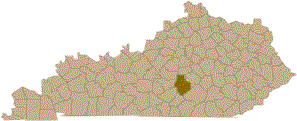|
The Fincastle Surveys
From Sandi Gorin & The SCKY
Mailing List
As you well remember, before 1792, there was no
Commonwealth of Kentucky. The lands lie in Virginia and the last county
claiming our lands was Fincastle County, Virginia and Kentucky was also
known as Kentucky County, Virginia. In April of 1774, a group of
surveyors headed out to begin surveying the area that would many years
later end up as the original three counties in Kentucky. Some of the
Fincastle surveys laid outside of Kentucky, but for the major part, the
men appointed were tromping through the wilderness areas seldom seen by
the white man. It must have been an awesome task; even more desolate
than when settlers started coming into
Kentucky en masse after the Revolutionary War. Only a few brave souls
had been in our land and the surveyors were met with challenges every
step of the way.
Surveyors included John Floyd, Hancock Taylor, James Douglas and Jesse
Hite who departed from Smithfield, Virginia and began their trek by boat
down the Kanawha and Ohio Rivers. At every spot along the way, they
sketched out their surveys with the help of their work crew. Can you
imagine the excitement, fear and wonder these men experienced? Trees so
thick it blotted out the sky. Rivers and creeks so pure that one could
see to the bottom? Animals of every variety and always the illusive
Native American who might be around the next bend.
The men reached the Falls of the Ohio on the 28th of May, a long trip
already. Fatigue must have overcome them at times, but the lure of the
new lands pushed them on. Twenty-eight surveys were done after their
arrival at the Falls covering 40,000 acres. This would encompass the
present-day city of Louisville running south to the Watterson Expressway
and east to Anchorage. On June 3rd the surveyors split into two groups -
one headed by Hancock Taylor. Taylor surveyed the area around
Harrodsburg and then moved
over to near Frankfort on the 17th. John Floyd, leader of the second
party, rejoined Taylor on July 1st and they camped near present day
Midway, KY.
Now they split into 3 parties with James Douglas and Isaac Hite in the
third group. Floyd surveyed the North Fork of Elkhorn; Taylor went along
the South Fork of the Elkhorn and Douglas along Jessamine and Hickman
Creeks. Sixty-two surveys were completed here for about 113,000 acres.
Remember now, they didn't have the fancy tools that surveyors do today,
these were men on foot carrying heavy chains, marking the lines of each
survey by cutting slashes in trees to mark the boundaries or piling
rocks up with a notation on it. Long, arduous work.
An Indian attack on July 8th stopped any plans of the men reuniting at
Harrodsburg and the men started for home by different routes. Two men
were lost on the 27th when Indians attacked Taylor's group and killed he
and another man. To the remaining surveyors and their crew came to
rescue the noted Daniel Boone and Michael Stoner, scouts sent out by
Virginia for this very purpose. Floyd and his companions came back by
following an Indian trail that led up the North Fork of the Kentucky
River and through the Pound Gap. Douglas' group paddled their way home
in a small canoe down the
Ohio and Mississippi Rivers and then catching a ride on a ship headed to
Virginia.
The weary men who had survived returned to Fincastle County and
presented their surveys - likely water soaked, perhaps blood stained and
ragged. The survey work did not stop with these four men however;
surveyors continued to come into Kentucky during the years 1775 and 1776
until finally over 206,250 acres had been surveyed. These were primarily
done on the old military warrants from the central part of the state.
Further information can be found in an article entitled: "Fincastle
Surveyors in the Bluegrass,
1774" by Neal Hammon, found in the Kentucky Historical Society Register
70, October 1972.
What was involved in these Virginia surveys? Virginia had to do
something - after the Revolutionary War, settlers began flooding into
the Kentucky County area, primarily since Virginia had paid its soldiers
by giving them land there. Many of the surveys were totally inaccurate
and were known as "tomahawk surveys" or what Henry Clay called "fireside
surveys." It caused problems for Virginia and later Kentucky for many
years. The original surveyors came out of William and Mary College which
the guidelines for surveying had been designed. After Kentucky
statehood, Kentucky set forth
its own rules and regulations for "ascertaining internal land boundaries
and property recording and determining the validity of warrants and
deeds." With the 2nd Kentucky Constitution, each county was to submit
the names of two proper persons, who, with the consent of the Senate,
one was appointed a county surveyor. If no one's name was submitted from
a county, the Governor submitted a name and was approved or disproved by
the Senate. It
was not until January 1814 that the Kentucky General Assembly finally
specifically outlined the requirements for surveyors.
(c) Copyright 15 May 2003, Sandra K Gorin, All Rights Reserved.
Sandi's Puzzlers:
http://freepages.genealogy.rootsweb.com/~gensoup/gorin/puz.html
SCKY Links:
http://www.public.asu.edu/~moore/Gorin.html
GGP:
http://ggpublishing.tripod.com/
==== SOUTH-CENTRAL-KENTUCKY Mailing List ====
|

